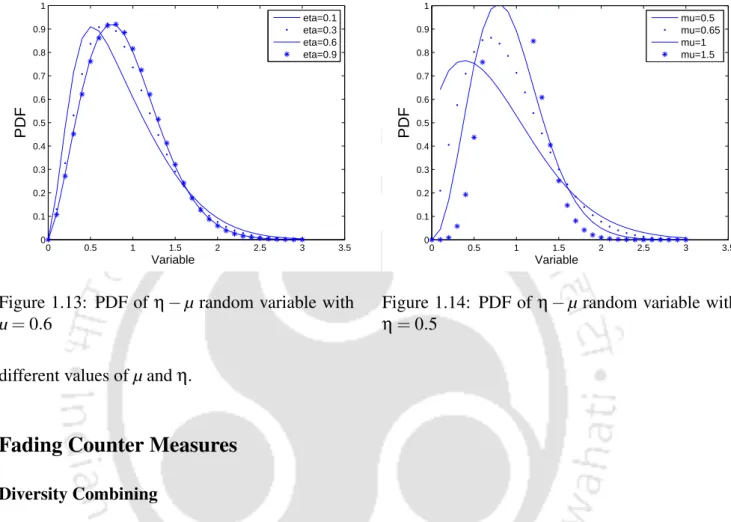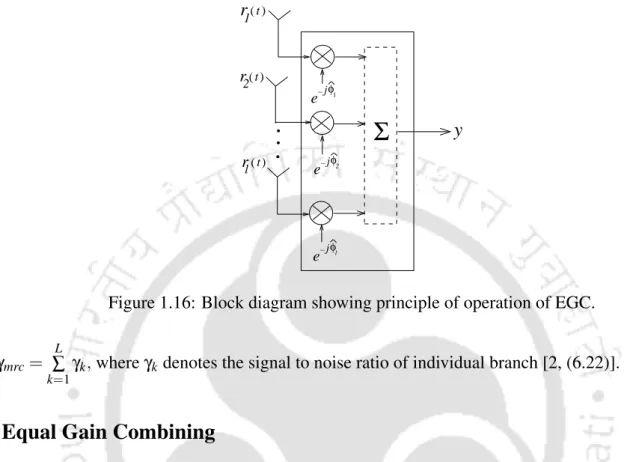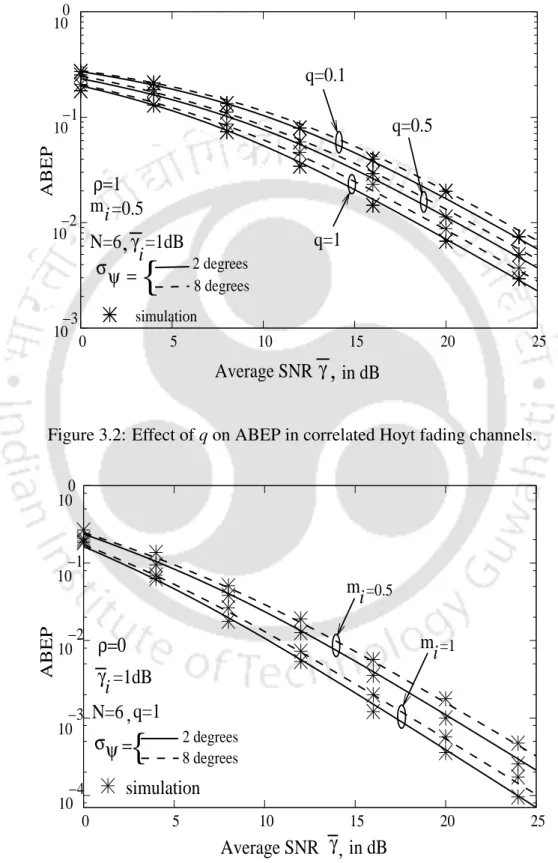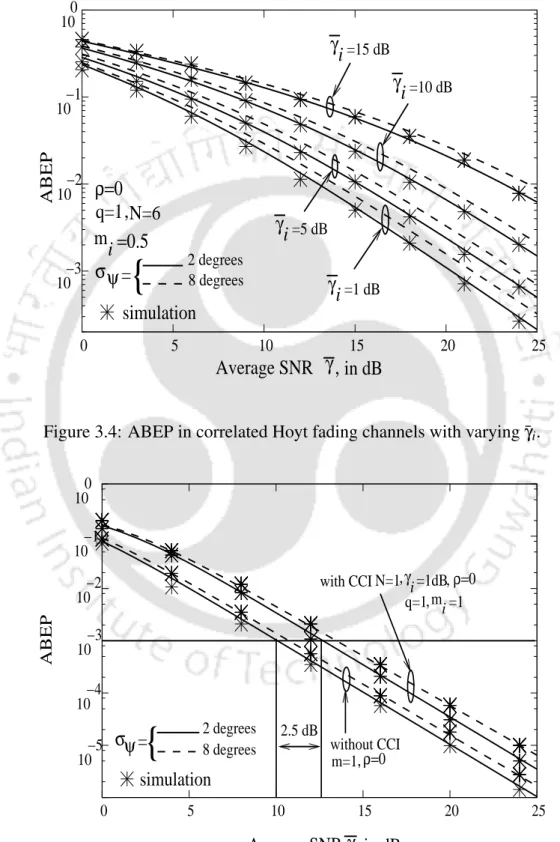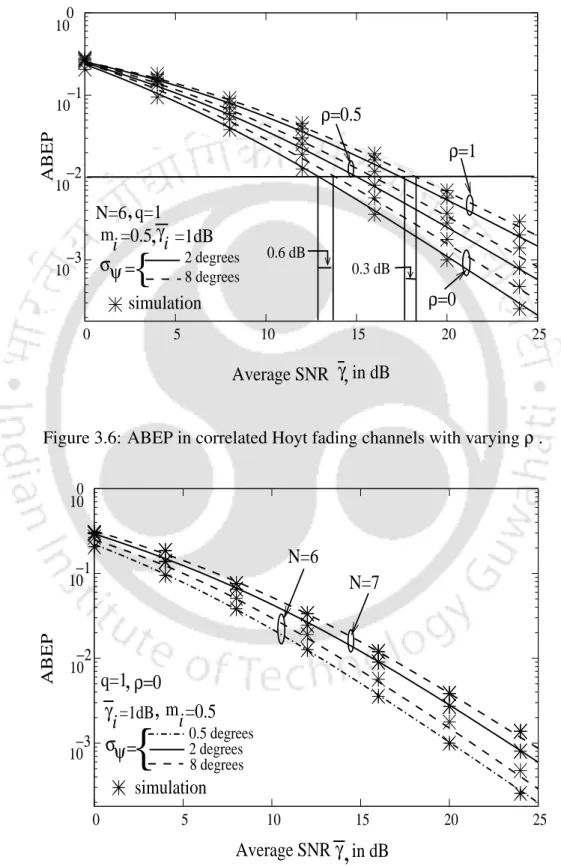In the literature, the analysis of combined diversity receivers in the presence of phase estimation error and CCI has not received enough attention. Analysis of system performance in the presence of phase estimation error, CCI and AWGN is certainly complex.
Cellular Communication System
Causes of Performance Degradation
Fading
The amount of frequency shift in the received signal relative to the transmitted signal is called Doppler spread. When the bandwidth of the channel is larger than the bandwidth of the signal, the received signal will fade flat.
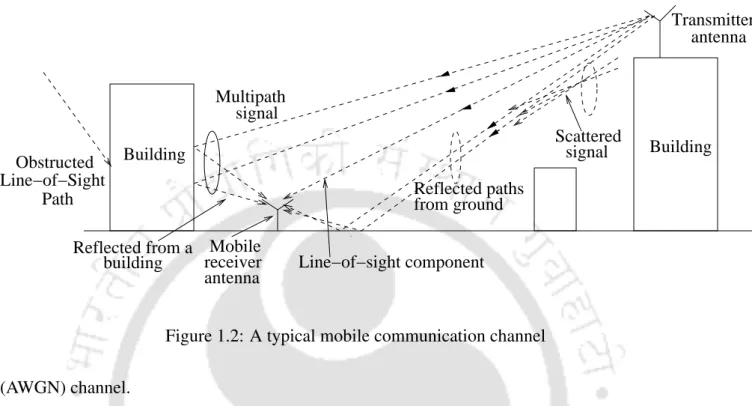
Phase Estimation Error
Co-channel Interference
For effective mobile communication, it is necessary to design a receiver that can perform satisfactorily in the presence of these effects. In this thesis, we analyze the outage and performance of EGC and MRC diversity combining ABER schemes in the presence of CCI and phase estimation errors for different fading environments.
Literature survey
In [25], the performance analysis of MRC receiver with imperfect channel estimation in the presence of CCI is presented. The performance of MRC diversity in the presence of multiple CCI interferers and AWGN was presented.
Motivation
Yacoub also presented two general fading distributions, the κ−µ distribution and the η−µ distribution, and proposed fading models for the distributions [12]. To be specific, the performance analysis of EGC and MRC receivers is analyzed in the presence of phase error and CCI.
Problem Formulation
Second, the CCI signals are assumed to be in perfect synchronization with the desired user. In literature, very little research work is presented on the performance analysis of diversity receivers with CCI, considering both noise and asynchronous case of desired user and interfering user.
Thesis Contribution
So all in addition to fading, the problem of phase error, interference with AWGN is considered together for analysis.
Thesis Organization
System Model
Interfering users can transmit asynchronously with τi as the delay of the i-th signal of the interfering user with respect to the signal of the desired user. In other words, the degradation caused by CCI to the signal of the desired user is the largest, in the worst case, when considering the interference as synchronous compared to asynchronous CCI users.
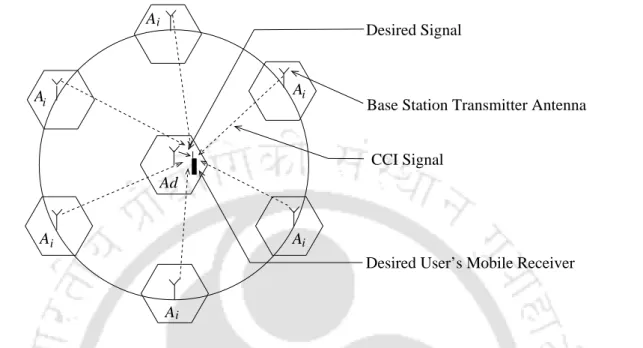
Gaussian Assumption for Cochannel Interference
To counteract the effects of fading on the desired user's receiver performance, we assume that an L-branch EGC diversity combiner as discussed in Section 1.2.1 (Figure 1.16) is implemented for receiving signals. Assuming that the desired user's transmitter and N CCI users transmit asynchronously, the complex baseband received signal at the 1st antenna of the EGC over a symbol duration T can be expressed from Eq.
Performance Analysis Methods
Probability Density Function Based Method
It is defined as the probability that the output SNR falls below a certain thresholdγth. The conditional average bit error rate (ABER) over the distribution of fading channel and is given by [3, (1.8)].
Moment Generation Function Method
Thus, the expression for ABER can be obtained by replacing equation 2.7 with equation 2.6 and solving the finite integral. Since the MGF term in Equation 2.7 is an infinite power series, the Pad´e approximation method can be used to obtain the sum.
Applying Pad`e Approximation Method for Analysis of EGC Receiver
EGC receiver is more because the output SNR is the square of the sum of received signal amplitudes. In addition, derivation of the PDF of the output SNR with phase error is not possible for different fading channels considered in the thesis, such as correlated Hoyt, generalized gamma and generalized-K.
Characteristic Function Based Method
If the receiving antennas of the combiner are far enough apart, the received signals can be statistically independent. Therefore, an expression for the PDF of the SINR is required for the analysis of the system under consideration. To obtain the PDF of SINR we need an expression for the joint PDF of the variable L- over RV.
An expression for the PDF of the SINR at the output of the dual EGC receiver can be obtained by inserting L=2 into Equation 3.2, as N0 is the SNR of the received CCI signal on the lth input branch of the EGC.
ABEP Evaluation Method
Correlated Hoyt Fading Channels
Thus, the MGF of the dual-EGC output SNR can be obtained from Equation 2.7 by substituting Equation 3.9 into it. Then ABEP for BPSK modulation can be obtained by the numerical integration of Equation 2.8 using the above obtained MGF in it. The ABEP performance of the dual-EGC receiver for correlated Hoyt fading channels is numerically evaluated and plotted in Figures 3.1-3.7 for BPSK modulation.
It can be observed that when N increases, the ABEP decreases correspondingly, as expected, due to the increase in the CCI signal. It can be observed that as the value of γi varied from 1 dB to 15 dB, the performance decreases gradually, as expected.
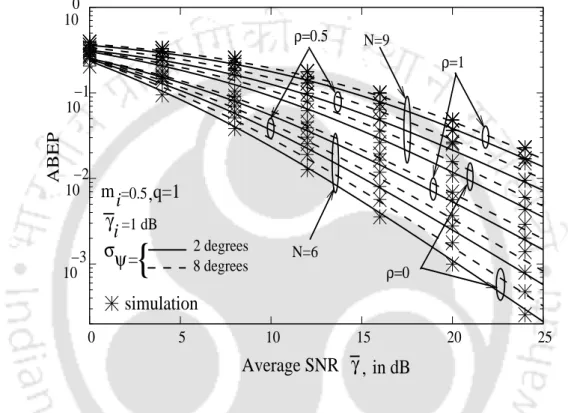
Composite and Non-homogeneous Fading Channels
Substituting Equations 3.6, 3.7, and 3.10 into Equation 3.5 and simplifying the resulting expression, we obtain E[γnegc] for GG distribution given by. Substituting Equations 3.6, 3.7 and 3.12 into Equation 3.5 and simplifying the resulting expression, we get E[γnegc]forη−µdistribution and it is given by. Substituting Equations 3.6, 3.7 and 3.13 into Equation 3.5 and simplifying the resulting expression, we get E[γnegc]forκ−µdistribution and it is given by.
The ABEP performance of the EGC receiver for GG fading channels is numerically evaluated using the method in Section 3.1.1 and is shown in the figures for BPSK modulation. For the KGfading channel, Figure 3.12 shows ABEP versus average SNR in (dB) for different values of N, ρ, σψ.
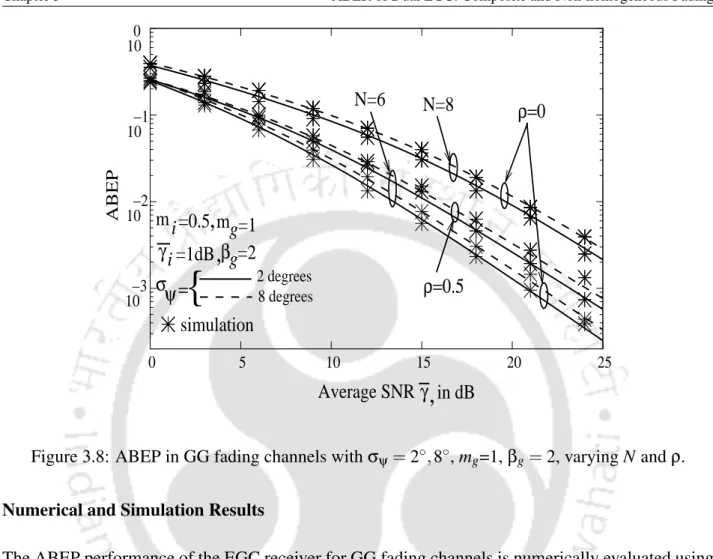
Independent Nakagami-m Fading Channels
Each of the disturbance sources is represented by a random time series zi[n] with the following properties (1). The instantaneous output SINR for the asynchronous case derived in Appendix A.6 can be given as It can be observed that the asynchronous case provides better performance than the synchronous case.
This is due to the fact that synchronous case overestimates the CCI power compared to asynchronous case, as discussed in section 2.1. Computer simulation results are also plotted in all figures to verify the correctness of the numerical results.

Performance of Dual-EGC in Nakagami-m Fading - PDF Based Approach
- Probability Density Function of Output SINR
- Outage Probability
- Average Bit Error Probability
- Numerical and Simulation Results
After a series of mathematical steps as shown in Appendix (A.9.1), the PDF of γegc can be derived as. The average bit error probability of γegc for BPSK modulation can be numerically evaluated as Pe=. Output and ABEP performance of dual-EGC receiver evaluated numerically and shown in figures for BPSK modulation assuming ζi=ζandσψ≈1/√.
The ABEP results compared to the ABEP results obtained in the MGF and Pad´e approximation method agree closely with the ABEP results obtained in the PDF method.
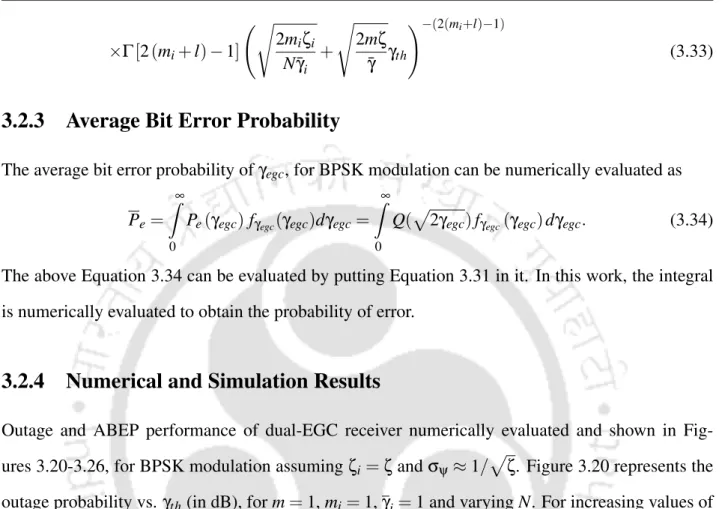
Outage of L-EGC over Composite Fading Channels
Output Signal-to-Interference Ratio
Since Ncochannel interferences are i.i.d with the identical fading parameter, and average power, the instantaneous jamming voltage phasors are added together to produce the resulting instantaneous jamming signal with resultant jamming power ∑N.
Outage Probability of Output SIR
Evaluation of the outcome probability for GG and KG fading using equation 3.39 thus requires evaluation of equation 3.42 and equation 3.44. It may be mentioned here that for Nakagami mfading channels a closed-form expression for CHF in (3.44) is available for uniform phase error in [33].
Numerical and Simulation Results
Performance of L − EGC in Nakagami-m Fading with Phase Error and AWGN Only
- Output SNR
- Probability Density Function of Output SNR, γ egc
- Outage Probability of Output SNR
- Average Bit Error Probability of Output SNR
- Numerical and Simulation Results
An expression for the PDF of γegc is derived as shown in Appendix A.8 in Equation A.44. The outage probability of EGC receiver with phase estimation error can be derived as Pout. The outage probability and ABEP performance of the EGC receiver were numerically evaluated and shown in Figures and 3.38 for BPSK modulation.
For decreasing the value from 1 to 0.5 the performance degrades, but for increasing from 2 to 4 it gives a better performance. But when the value of eL decreases from 4 to 2, m decreases from 1 to 0.5 the performance decreases.
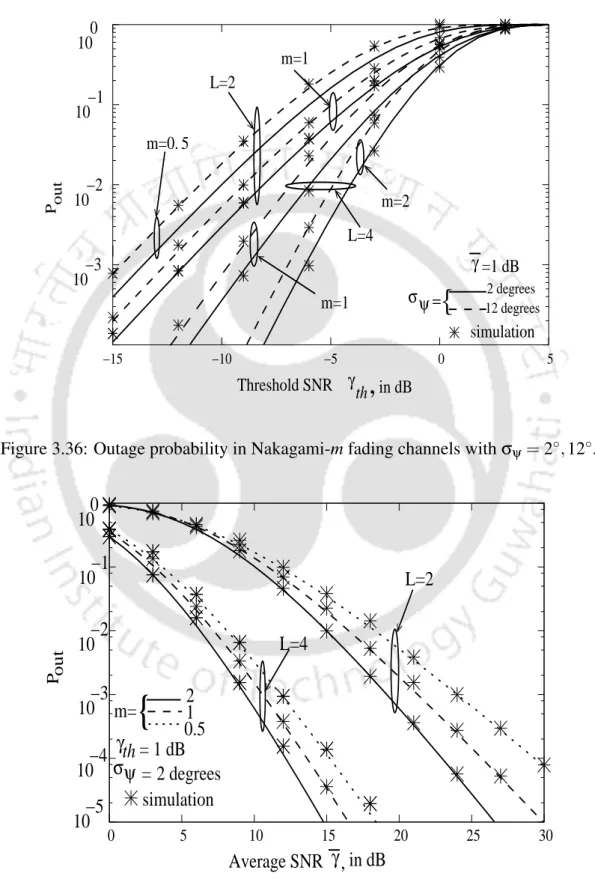
Summary
In this chapter, we derive expressions for the interruption and ABEP of MRC receiver in Nakagami mfading channels and study the performance. According to the system model discussed in Section 2.2, the desired user's channel and the interfering user's channel are considered Nakagami-m fading. Thus, in Equation 2.2, αl,s is assumed to be Nakagami-mdistributed RV with fading parameter mandal,i is assumed to be i.i.d Nakagami-m RV with fading parameter mi.
An expression for the demodulated signal at the output of the combiner at the time of sampling is derived in Appendix A.10. Γ(mL)e−mγ¯ ηx, (4.6) where is the fading parameter and ¯γ is the average SNR of the user's desired Nakagami-m distributed signal.
Outage Probability of MRC Output SINR
By substituting Equation 4.6 and Equation 4.7 into Equation 4.10, the outage probability can be given as Pout(γth) =. 4.11) The integration in Equation 4.11 can be evaluated as shown in Appendix A.10.2 and the final expression for outage probability can be given as.
Average Symbol Error Probability
Numerical and Simulation Results
Summary
The performance measures considered are combiner output SNR, failure probability and system ABEP. The received signal at the three receiving antenna of the EGC combiner is given in equation 2.2 as rl(t) =al,sejϕl,sss(t) +nl,s(t). The receiver estimates the phase of the desired signal and uses a matched filter with impulse response gT(T−t).
Let the estimated phase of the carrier for the desired signal received at the ltth antenna be bee−jbϕl,s. From equation A.1, the sampled output of the matched filter att=T can be obtained as yl = asal,sejψl,s.
Output SINR of EGC Receiver
Hence, the combined signal sample at the L-branch EGC receiver output can be written as.
Joint Moments of Correlated Hoyt Fading Channels
Derivation of Joint Moments of GG RVs
Derivation of Joint Moments of Generalized-K RVs
Derivation of EGC Output SINR in Asynchronous Case
The second expectation term in Equation A.23 can be derived by following the same procedure used for the synchronous case in Equation A.8, which.
Derivation of PDF of γ egc =
Derivation of Outage Probability of EGC
By applying formula to the above equation and simplifying the terms, the probability of failure can be expressed as.
Derivation of Average Bit Error Probability
Derivation of γ egc with Phase Error and CCI - PDF Based Approach
Derivation of PDF of γ egc
Derivation of Outage Probability of EGC
Output SINR of MRC Receiver
- Derivation of PDF of x in Section 4.1
- Derivation of PDF of γ mrc
- Derivation of Outage Probability of MRC
- Derivation of ASEP of MRC
By substituting the PDF of xandz from Equations 4.6 and 4.7 into Equation 4.5, the PDF of γmrcca can be expressed as. By applying formula given in Equation A.95) to the first integration and binomial expansion (Equation A.88) to the second integration of Equation A.73, an expression for Pout(γth) can be given as Applying the formula given in Equation A.95) to evaluate the integration in Equation A.74 and rearranging the terms, the closed expression for Pout can be given as gγsinmrc2θ.
Applying Equations 11, 12 and 13 of [25], the integral in Equation A.78 can be evaluated and the expression for pecan obtained as
Pad´e Approximation
Pad´e Approximation Coefficients in the Numerical Evaluation of Equation 2.8 for
Pad´e Approximation Coefficients in the Numerical Evaluation of Equation 2.8 for
Pad´e Approximation Coefficients in the Numerical Evaluation of Eq. 2.8 for Nakagami-
List of Formulas
- A typical mobile communication channel
- PDF of Rayleigh random variable
- PDF of Nakagami-m random variable
- PDF of Hoyt random variable
- PDF of Rician random variable
- PDF of Weibull random variable
- PDF of Generalized-Gamma random variable
- PDF of K G random variable with m = 1
- PDF of K G random variable with k = 2.5
- PDF of κ − µ random vairable for µ = 0.5
- PDF of κ − µ variable for κ = 1
- PDF of η − µ random variable with µ = 0.6
- PDF of η − µ random variable with η = 0.5
- Block diagram showing principle of operation of MRC
- Block diagram showing principle of operation of EGC
- Desired and CCI signal in cellular communication system. A d is the desired user’s
- ABEP in correlated Hoyt fading channels with varying N and ρ
- Effect of q on ABEP in correlated Hoyt fading channels
- Effect of m i on ABEP in correlated Hoyt fading channels
- ABEP in correlated Hoyt fading channels with varying ¯ γ i
- Comparison of ABEP of in correlated Hoyt fading channels with and without CCI. 43
- ABEP in correlated Hoyt fading channels with N = 6 and N = 7
- ABEP in GG fading channels with σ ψ = 2 ◦ , 8 ◦ , m g =1, β g = 2, varying N and ρ
- ABEP in GG fading channels with σ ψ = 2 ◦ , 8 ◦ , β g = 2 and varying m g
- ABEP in GG fading channels with σ ψ = 2 ◦ , 8 ◦ , m g = 1, β g = 2 and varying m i
- ABEP in GG fading channels with σ ψ = 2 ◦ , 8 ◦ , m g = 1, β g = 2 and varying γ i
- ABEP in K G fading channels with σ ψ = 2 ◦ , 8 ◦ and varying ρ , N
- ABEP in K G fading channels with σ ψ = 2 ◦ , 8 ◦ and varying m k
- ABEP in η − µ fading channels with σ ψ = 2 ◦ , 8 ◦ and varying N and µ
- ABEP in κ − µ fading channel with σ ψ = 2 ◦ , 8 ◦ , κ = 0 and varying µ
- ABEP in independent Nakagami-m fading channels with σ ψ = 2 ◦ , 8 ◦ , m = 1, m i =1
- ABEP in independent Nakagami-m fading channels with σ ψ = 2 ◦ ,8 ◦ , N = 6 and γ i
- ABEP in independent Nakagami-m fading channels with varying γ i
- Comparison dual-EGC in Nakagami-m fading channels for synchronous and asyn-
- Outage probability in Nakagami-m fading channels with σ ψ = 2 ◦ , 12 ◦ and varying N. 65
- ABEP in correlated Hoyt fading channels with varying N, σ ψ at γ = 5 dB
- ABEP in correlated Hoyt fading channels with varying N, ρ , σ ψ
- ABEP in GG fading channels with varying N, ρ and σ ψ
- ABEP in K G fading channels with varying N, ρ and σ ψ
- ABEP in Nakagami-m fading channels varying N, σ ψ for γ = 10 dB
Tsiftsis, “On the performance analysis of equal-gain diversity receivers over generalized Gamma-fading channels,” IEEE Trans. Beaulieu, “Outage probabilities of diversity cellular systems with cochannel interference in Nakagami fading,” IEEE Trans. Heath, “Performance analysis of maximum ratio combines with imperfect channel estimation in the presence of cochannel interferences,” IEEE Trans.
Karagiannidis, “Moment-based approach to the performance analysis of equal gain diversity in Nakagami mfading,” IEEE Trans. Kotsopoulos, “Equal gain combining over Nakagami-n (Rice) and Nakagami-q (Hoyt) generalized fading channels,” IEEE Trans.
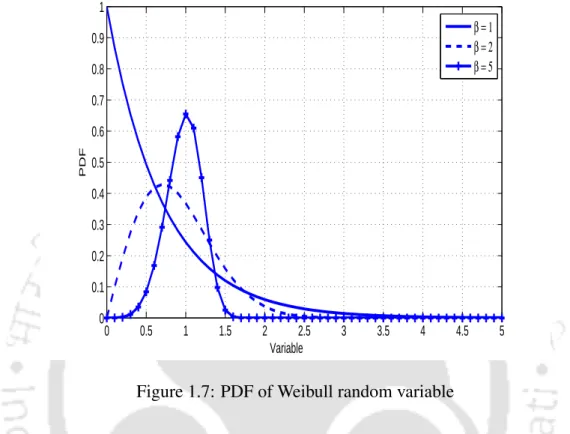
![Figure 1.8: PDF of Generalized-Gamma random variable fading is given by [7, 8].](https://thumb-ap.123doks.com/thumbv2/azpdfnet/10344554.0/31.892.116.753.239.798/figure-pdf-generalized-gamma-random-variable-fading-given.webp)
